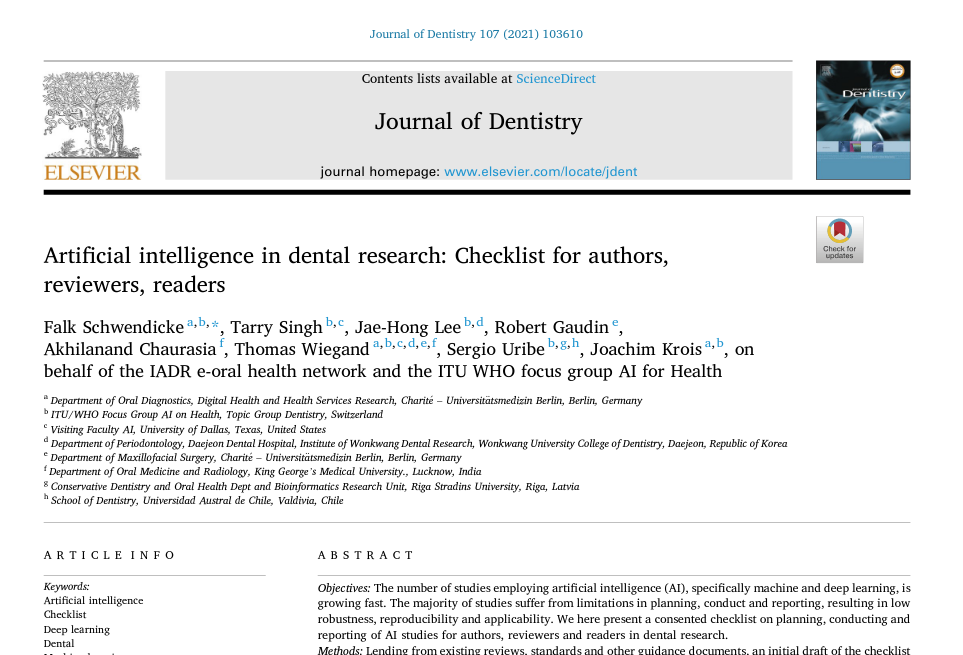Selected Artificial Intelligence in Dentistry papers
FDI White Paper on Artificial Intelligence - DOWNLOAD PDF
|
The FDI White Paper on Artificial Intelligence explores AI's potential benefits and challenges in dentistry across four key domains: individual patient care, community and public health, education and the workforce, and research. AI can improve patient care through image analysis, predictive dentistry, evidence-backed planning, therapeutic recommendations, and patient communication. It also plays a vital role in oral health surveillance and serving underserved populations. In education, workforce planning, diversification, and research, AI promises significant impacts. However, there are concerns regarding bias, accessibility, interoperability, and data protection when implementing AI in dentistry.
Who should read this paper? Every dentist who wants to understand AI technology and its potential impact on dental practice. By understanding the opportunities and challenges associated with AI in dentistry, dentists can make informed decisions about integrating this technology into their practice to improve patient outcomes while ensuring data protection and ethical considerations are met. Schwendicke, F., Blatz, M., Uribe SE, C.W., Verma, M., Linton, J., and Kim, Y.J. (2023). Artificial Intelligence for Dentistry - FDI White Paper (International Dental Federation). DOWNLOAD PDF |
Artificial intelligence in dental research: Checklist for authors, reviewers, readers - DOWNLOAD PDF
|
This paper provides authors, reviewers, and readers with a checklist to ensure the proper use and reporting of artificial intelligence (AI) in dental research. The checklist includes 31 items covering planning, conducting, and reporting AI studies in dentistry.
Following this checklist can help overcome weaknesses in current AI studies and advance research while facilitating a debate on standards in the field. Who should read this paper? Dentists who are interested in incorporating AI into their practice or conducting research using AI can benefit from reading this paper as it guides how to plan, conduct, and report such studies properly. Schwendicke, F., Singh, T., Lee, J.-H., Gaudin, R., Chaurasia, A., Wiegand, T., Uribe, S., Krois, J., and IADR e-oral health network and the ITU WHO focus group AI for Health (2021). Artificial intelligence in dental research: Checklist for authors, reviewers, readers. J. Dent. 107, 103610. DOWNLOAD PDF |
Artificial intelligence for oral and dental healthcare: Core education curriculum - DOWNLOAD PDF
|
This paper presents a core education curriculum for undergraduate and postgraduate dental students to learn about artificial intelligence (AI) in oral and dental healthcare. The curriculum includes learning outcomes related to the basics of AI, its applications in dentistry, ethical considerations, and practical skills for evaluating and using AI tools.
Who should read this paper? This paper is a must-read for every dentist in academia and education to gain a comprehensive understanding of the basics of AI in dentistry, to know what are the essential aspects of AI that should be in the dental curriculum and its importance in shaping the future of dental curriculum. Schwendicke, F., Chaurasia, A., Wiegand, T., Uribe, S.E., Fontana, M., Akota, I., Tryfonos, O., Krois, J., and IADR e-oral health network and the ITU/WHO focus group AI for health (2023). Artificial intelligence for oral and dental healthcare: Core education curriculum. J. Dent. 128, 104363. DOWNLOAD PDF |
Deep learning for caries detection: A systematic review. - DOWNLOAD PDF
|
This paper offers a systematic review of deep learning techniques for caries detection, an area recognized for its complexity in dental diagnostics. This comprehensive review examines diagnostic accuracy studies that employ deep learning models on a variety of dental images, from radiographs to near-infrared transillumination images.
Key Findings:
|




